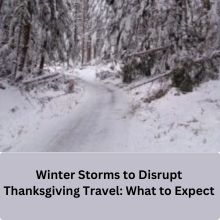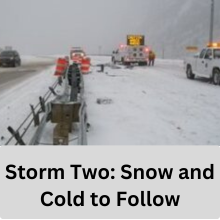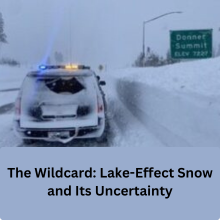As millions of Americans prepare to travel for Thanksgiving, a powerful winter storm is set to disrupt plans, bringing a mix of heavy snow, cold temperatures, and severe weather. With the holiday travel rush right around the corner, this storm could wreak havoc on travel routes, airports, and road conditions nationwide. Here’s a comprehensive guide to understanding what the storm entails and how to prepare for its impact.
The Coming Storm
Winter storms in the U.S. are notorious for causing travel chaos, and this one is no exception. What makes this storm particularly dangerous is its timing—arriving just as millions of people are hitting the roads and airports for Thanksgiving. The storm will come in two parts, each with its own set of hazards.
- Storm One will bring heavy rain and the potential for tornadoes in the southern and central Plains, as well as concerns for flooding due to the already saturated ground.
- Storm Two, the second part of the system, will bring snow, strong winds, and plummeting temperatures, particularly across the Midwest, Great Lakes, and Northeast.
How Severe Weather Could Affect Thanksgiving Travel
Thanksgiving is one of the busiest travel periods in the U.S., with millions of people expected to drive, fly, or take trains to their holiday destinations. Severe weather can lead to flight delays, cancellations, road closures, and dangerous driving conditions, adding to the stress of travelers trying to make it to their destinations.
The storm is forecasted to intensify in the coming days, and if you’re traveling, you’ll need to stay flexible. Whether you’re heading out on the road or taking a flight, it’s essential to stay updated on the weather forecast and be prepared for disruptions.
Storm One: Severe Weather and Flooding Threat
The first part of this storm system will bring severe weather to the southern and central Plains, areas that have been grappling with heavy rain since the beginning of November. The FOX Forecast Center has already noted that these regions have received anywhere from 3 to 12 inches of rain, which has helped alleviate drought conditions. However, the extra rain in the coming days could push the region into flash flood territory.
As this first system pushes through, tornadoes and damaging winds are also a possibility. The threat of flooding remains high, especially in low-lying areas and places where the ground is already soaked.
Storm Two: Snow and Cold to Follow
After the first storm moves northward into Canada, a low-pressure system is expected to form in the Ohio River Valley and rapidly intensify. This second system will bring cold air, strong winds, and snow to the Great Lakes and parts of the Northeast.
Expect snow to develop across the Ohio Valley and extend into the Appalachian Mountains. This could result in treacherous driving conditions, particularly along I-70 and I-80, where snow accumulation could cause major disruptions. The snowstorm will then move eastward, potentially affecting cities like New York, Philadelphia, and Boston by the end of the week.
The Ohio River Valley: Snow, Ice, and Wind
Regions across the Ohio River Valley are expected to see the heaviest snowfalls, especially in areas like Indiana, Kentucky, and Ohio. In addition to snow, ice accumulation is also a concern, as freezing rain could create slick surfaces on roads, sidewalks, and power lines. Strong winds, with gusts reaching up to 50 mph, will worsen conditions, leading to low visibility and dangerous travel.
The Appalachian Mountains will also see significant snowfall as the cold air moves in. Higher elevations are expected to accumulate several inches of snow, making roads impassable in some areas.
Northeast and Mid-Atlantic: The Snowstorm’s Path
As the storm continues eastward, it will bring snow and wind to the Northeast and Mid-Atlantic regions. Cities like New York, Boston, and Washington, D.C., could experience snow accumulation, with some places getting up to 6 inches by the weekend. However, the amount of snow will depend on the storm’s exact path, so there’s still some uncertainty.
In addition to snow, expect strong winds, particularly along the coast. Coastal flooding could also occur if the storm strengthens over the Atlantic.
The Wildcard: Lake-Effect Snow and Its Uncertainty
One of the most unpredictable aspects of this storm is the potential for lake-effect snow, which can develop if the storm’s path moves over the Great Lakes. This type of snow is notorious for its heavy, localized snowfall that can cause major disruptions in places like Buffalo and Cleveland. However, the occurrence of lake-effect snow depends on the storm’s exact track, so it’s not yet clear whether it will be a significant factor.
Regional Breakdown: Storm’s Impact by State
New Mexico: Heavy rain and snow at higher elevations will continue across New Mexico as the storm moves in. Areas above 8000 feet could see up to 8 inches of snow, especially in the Gila National Forest and the Sangre de Cristo Mountains. Winter weather advisories have already been issued for parts of the state, so residents and travelers should be prepared for slippery conditions.
Midwest & Northeast: Snow and strong winds will affect much of the Midwest and Northeast, with significant accumulation expected in cities like Cleveland, Detroit, and Buffalo. The storm will also bring cold temperatures, leading to icy conditions on the roads.
Great Lakes & Ohio Valley: The storm’s path will bring snow to much of the Great Lakes region, especially over Michigan, Ohio, and northern Indiana. Wind gusts of 40-50 mph will complicate travel and reduce visibility.
Also read: 2025 Social Security Changes:One Move to Protect Your Future
Preparing for Winter Weather: How to Stay Safe
Traveling in winter storms can be dangerous, but with the right preparation, you can stay safe. Here are some tips:
- Travel in daylight: Snowstorms and icy conditions are much harder to navigate at night.
- Check road conditions: Before leaving, make sure you know which routes are closed or unsafe.
- Pack emergency supplies: Carry extra blankets, water, food, and a flashlight in case of delays.
- Dress appropriately: Layer up with warm clothing and make sure you have proper winter gear, like gloves and boots.
The Big Picture: Long-Term Forecast for Thanksgiving Week
While the storms will cause disruptions during the week leading up to Thanksgiving, there is some good news: The worst of the weather is expected to clear by Thursday, just in time for Thanksgiving Day. Still, travelers should expect lingering effects, especially in the Midwest and Northeast. Conditions should improve by Friday, but the aftermath of the storm could cause delays as travelers head home.
The Science Behind the Storms: How Meteorologists Predict Severe Weather
Meteorologists use advanced technology to predict severe weather events like winter storms. Satellite imagery, weather radar, and computer models help forecasters track the storm’s development and path. This information is crucial for providing early warnings and giving people time to prepare.
Monitoring the Storms: How to Stay Informed
To stay informed about the latest updates on the storm, download reliable weather apps like Fox Weather. These apps provide real-time notifications and updates on the storm’s progress, so you’ll know when to expect severe weather in your area.
Also read: Experience Bhutan’s Spiritual Secrets and Ancient Festivals
Conclusion
In summary, a powerful winter storm is set to disrupt travel plans ahead of Thanksgiving, bringing snow, rain, and severe weather across the country. While the worst of the storm should pass by Thursday, travelers should remain vigilant and be prepared for delays and dangerous conditions. By staying informed and planning ahead, you can help ensure a safe and stress-free holiday season.
FAQs
How can I stay safe when traveling during a winter storm?
Check road conditions, pack emergency supplies, and avoid traveling at night. Always follow weather warnings.
What are the chances of snowfall in my area this week?
It depends on your location. Cities in the Ohio Valley and Great Lakes have the highest chances of snow.
Will my flight be delayed due to the winter storms?
There could be delays, especially in the Northeast and Midwest, so check with your airline for updates.
How much snow is expected in the Northeast during Thanksgiving week?
Some areas could see up to 6 inches of snow, depending on the storm’s path.
How can I prepare my home for severe winter weather?
Stock up on essential supplies, secure outdoor items, and ensure your heating system is working properly.


